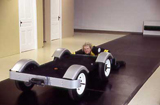Bruce Barber Interviews Rita
|
BB: In Bocca al Lupo/In the Mouth of the Wolf (1991) is one of your most ambitious works – a gesamtkunstwerk opera in the Wagnerian sense and one that I was privileged to experience in Halifax when it was first performed at Mount Saint Vincent University gallery. This work engaged multiple allegorical themes relating to the silencing of women by abuse, religion and academic institutions. You directed a six-person choir, two soloists, three musicians, and six dancers. How did you begin to structure this complex work?
RM: The research for the work led me to Catherine Clements’ book Opera, or The undoing of women (1988). I had been interested in bringing my music and art practice together in a more balanced form. The opera form contains a dramatic, poetic abstraction that allowed me to address my interest in relationships between women, anger and the physical and pathological manifestations of anger in the body. I was interested in how women deal with anger and how it develops. I was asked by Mary Sparling at Mount Saint Vincent University Gallery to propose an exhibition. I always look at the specifics of the site when trying to focus my research. Both the religious and academic structures represented by the University led me towards an articulation of the complex chorus of voices and gestures of women’s anger. I was interested in letting it all be heard simultaneously despite the chaotic and overwhelming nature of the result. BB: As a performance member sitting precariously on massive piles of books and journals at the edge of the structure I felt somewhat vulnerable in this space. You’ve stated that your desire with the piece was to address fear, examine it and let it speak. Do you think that fear can be addressed successfully in performance art? How gendered was this work? As a male was I supposed to be excluded from several registers of meaning within the work? Why did books and learning become one of your themes? RM: The books allowed me to bring the outside world of experiences into the gallery. The various titles referred to sites or situations where anger could have been generated. There was a humour to the juxtapositions of titles as in “This farm is a mess” beside “Your prostate,” etc. I realised that it could be uncomfortable sitting on the piles of books but I had hoped that if the body is restless or a bit uncomfortable then perhaps it is engaged in a more unexpected way. I have always hoped that if the audience of my work were in any way uncomfortable they would choose to leave. I assume that they will do what they need to do even if it affects the performance. I rely on that as it affords me a relationship with the viewer that is reciprocal. |
  |
